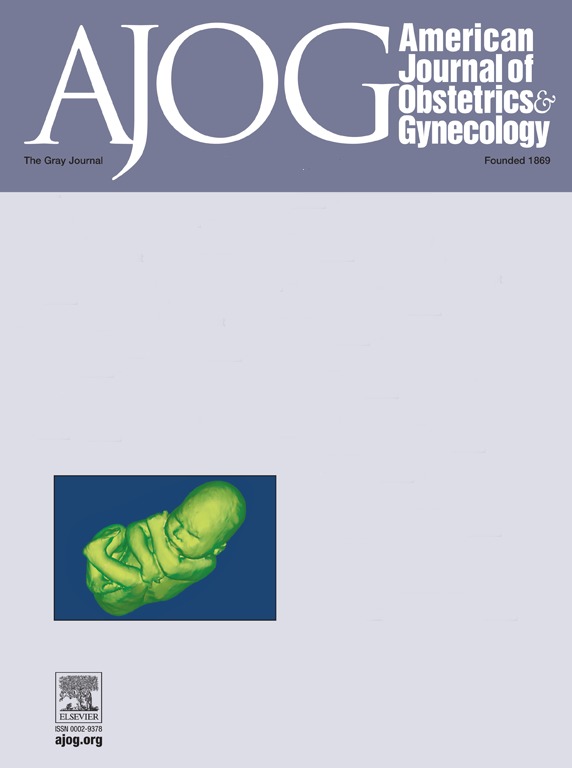Clinical outcomes following implementation of an operative vaginal birth safety bundle: A prospective observational study and time-series analysis.
IF 8.7
1区 医学
Q1 OBSTETRICS & GYNECOLOGY
引用次数: 0
Abstract
BACKGROUND Poor outcomes from operative vaginal birth are associated with failure to recognize malposition, lack of interdisciplinary communication and deviation from accepted guidelines. We implemented a safety bundle including routine intrapartum ultrasound, a structured time-out and procedural checklist, birth experience survey, and a postnatal debrief pathway. OBJECTIVES To compare clinical outcomes from operative vaginal birth before and after the implementation of a safety bundle at Monash Health, Melbourne, Australia. STUDY DESIGN We compared clinical outcomes pre- versus post-bundle implementation for all women having an operative vaginal birth or fully-dilated cesarean of a term singleton cephalic non-anomalous fetus at Monash Health. Data were prospectively collected following bundle implementation from August 2022 to August 2024 and compared to a historical control cohort from November 2019 to November 2021, before the initial pilot of the bundle. We performed an interrupted time-series analysis to assess change in outcome trends over time. The primary outcome was a composite of neonatal morbidity, including Apgar score <7 at five minutes, cord lactate >8mmol/L, significant birth trauma, intubation or cardiac compressions, therapeutic cooling, and neonatal intensive care unit admission. RESULTS We included 2,427 and 2,914 births meeting the inclusion criteria in the post- and pre-bundle periods, respectively. Following bundle implementation, mothers were older (30.5 ± 4.8 vs. 30.1 ± 4.9, p=.006), at a slightly later gestational age (39.5 [38.7, 40.3] vs. 39.4 [38.5, 40.2], p=.003), it was more common for specialist obstetricians to attend the birth (56.1% vs. 47.7%, p<.001), for ultrasound to be performed (55.8% vs. 5.0%, p<.001) and for vaginal station to be low (54.1% vs. 49.4%, p=.001), whilst it was less common to have occiput anterior position (71.2% vs. 74.4%, p=.03) or missing documentation of clinical assessment (0.8% vs. 3.4%, p<.001). There were no significant differences in rates of forceps, vacuum, or fully-dilated cesarean overall; however, following implementation there were more cesareans without attempted OVB (9.5% vs. 7.8%, p=.03), fewer births with ≥four tractions or ≥two cup detachments (5.8% vs. 8.5%, p<.001) and less unsuccessful OVB (6.3% vs. 8.3%, p=.005). There were no significant differences in the pre-defined neonatal composite morbidity (14.2% vs. 13.9%, p=.80); however, there were significantly fewer neonates delivered in an unexpected position (0.7% vs. 2.8%, p<.001), lower rates of severe neonatal birth trauma (1.3% vs. 2.5%, p<.001) and lower rates of neonatal intensive care admissions (1.8% vs. 2.7%, p=.02). There were higher rates of postpartum hemorrhage >1000 mL (17.6% vs. 15.2%, p=0.02), but no differences in blood transfusions (3.7% vs. 3.8%, p=0.96) or obstetrical anal sphincter injury (4.8% vs. 5.4%, p=0.38). Interrupted time-series analysis demonstrated significant step reductions in fully-dilated cesarean (-5.9%, 95%CI -11.77 to -0.11, p=.05), unsuccessful OVB attempt (-5.1%, 95%CI -8.74 to -1.37, p=.008) and cesarean for unsuccessful OVB (-2.4%, 95%CI -4.48 to -0.31, p=0.03), with no significant difference neonatal or maternal morbidity. CONCLUSIONS Implementation of a safety bundle for OVB reduced the rates of unsuccessful OVB and may reduce rates of neonatal birth trauma and neonatal intensive care admissions.实施手术阴道分娩安全束的临床结果:一项前瞻性观察研究和时间序列分析。
手术阴道分娩的不良结果与未能识别体位错误、缺乏跨学科沟通和偏离公认的指导方针有关。我们实施了一套安全措施,包括常规的产时超声检查、结构化的暂停和程序检查表、分娩经验调查和产后汇报路径。目的比较澳大利亚墨尔本莫纳什健康中心实施安全束前后阴道分娩手术的临床结果。研究设计:我们比较了莫纳什医疗中心(Monash Health)所有接受阴道分娩或剖宫产足月单胎头位无异常胎儿的妇女在分娩前后的临床结果。在2022年8月至2024年8月实施捆绑包后,前瞻性地收集了数据,并与2019年11月至2021年11月的历史对照队列进行了比较。我们进行了中断时间序列分析,以评估结果趋势随时间的变化。主要结局是新生儿发病率的综合指标,包括Apgar评分8mmol/L、明显的出生创伤、插管或心脏按压、治疗性冷却和新生儿重症监护病房入住情况。结果我们分别纳入了2,427例和2,914例在产后和产前符合纳入标准的新生儿。实施束产后,产妇年龄较大(30.5±4.8比30.1±4.9,p= 0.006),胎龄稍晚(39.5[38.7,40.3]比39.4 [38.5,40.2],p= 0.003),专科产科医生接生的情况较多(56.1%比47.7%,p1000 mL(17.6%比15.2%,p=0.02),但输血(3.7%比3.8%,p=0.96)或产科肛门括约肌损伤(4.8%比5.4%,p=0.38)无差异。中断时间序列分析显示,完全扩张剖宫产(-5.9%,95%CI -11.77至-0.11,p= 0.05)、OVB失败尝试剖宫产(-5.1%,95%CI -8.74至-1.37,p= 0.008)和OVB失败剖宫产(-2.4%,95%CI -4.48至-0.31,p=0.03)的步数显著降低,新生儿或孕产妇发病率无显著差异。结论:OVB安全包的实施降低了OVB不成功的发生率,并可能降低新生儿出生创伤和新生儿重症监护住院率。
本文章由计算机程序翻译,如有差异,请以英文原文为准。
求助全文
约1分钟内获得全文
求助全文
来源期刊
CiteScore
15.90
自引率
7.10%
发文量
2237
审稿时长
47 days
期刊介绍:
The American Journal of Obstetrics and Gynecology, known as "The Gray Journal," covers the entire spectrum of Obstetrics and Gynecology. It aims to publish original research (clinical and translational), reviews, opinions, video clips, podcasts, and interviews that contribute to understanding health and disease and have the potential to impact the practice of women's healthcare.
Focus Areas:
Diagnosis, Treatment, Prediction, and Prevention: The journal focuses on research related to the diagnosis, treatment, prediction, and prevention of obstetrical and gynecological disorders.
Biology of Reproduction: AJOG publishes work on the biology of reproduction, including studies on reproductive physiology and mechanisms of obstetrical and gynecological diseases.
Content Types:
Original Research: Clinical and translational research articles.
Reviews: Comprehensive reviews providing insights into various aspects of obstetrics and gynecology.
Opinions: Perspectives and opinions on important topics in the field.
Multimedia Content: Video clips, podcasts, and interviews.
Peer Review Process:
All submissions undergo a rigorous peer review process to ensure quality and relevance to the field of obstetrics and gynecology.

 求助内容:
求助内容: 应助结果提醒方式:
应助结果提醒方式:


